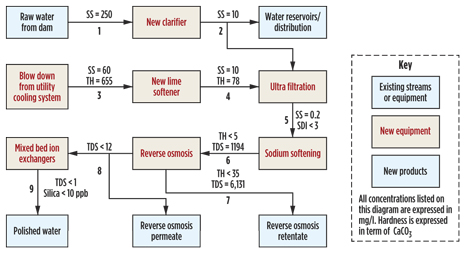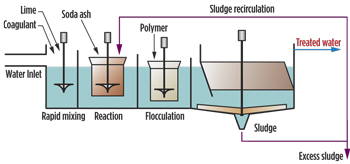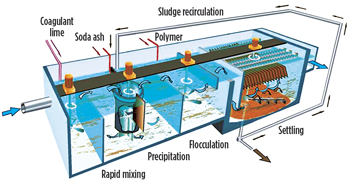PHILIPPE VALERIO, Veolia Water
South Africa’s coal-based synfuel producer, Sasol, has contributed to that country’s energy independence by supplying 30% of its fuel requirements. But when it needed additional processing and production capability at its 160,000-bpd coal-to-liquids (CTL) plant in Mpumalanga, the increased water demand placed potential constraints on the company’s expansion plans.
Before the comprehensive expansion project, termed “Project Turbo,” could be launched, a reliable source of demineralized (polished) water had to be determined. The new project would require approximately 20 million liters of water of various qualities daily, but a sustained drought in southern Africa made gaining additional raw water supplies virtually impossible. In addition, Sasol’s existing water treatment plants were already operating at maximum capacity and, therefore, unable to contribute to meeting the new demand required by Project Turbo.
Evaluation of available supplies ultimately led to the decision to reclaim blowdown water from the plant’s utility cooling towers as the primary water supply for capacity expansion. The treatment plant designed to accomplish this would handle variable blowdown quality and flowrates, plus be able to accept clarified raw water, or even potable water, if needed.
PROJECT LANDLORD
The new blowdown reclamation plant, initially termed “Project Landlord” (Unit 544 - Water Works Desalination), was designed, constructed and commissioned by Veolia Water Solutions & Technologies. Because the total dissolved solids concentration (TDS) in the blowdown stream was significantly higher than that of raw water, conventional ion exchange technology was deemed unsuitable. Membrane desalination, specifically spiral reverse osmosis (SRO), was chosen as the main desalination step. Since the plant commenced operations in mid-2006, the successful reclamation of 12 million liters/day of cooling tower blowdown has provided the extra capacity needed for Sasol’s Project Turbo, and has reduced the total raw water intake by approximately 6%.
The treatment plant is designed to produce 350 m3/hr of reverse osmosis (RO) permeate and 128 m3/hr of polished water. The quality specifications of the product streams are shown in Table 1.
| Table 1. Quality specifications of product streams (1) |
|

|
Because the cooling tower blowdown water exhibits high hardness and high concentrations of salt (Table 2), the first treatment stage is clarification and softening. Following this process, the water goes through submerged-membrane ultra-filtration, double-pass SRO and mixed-bed ion exchange to achieve the specified water quality required for Sasol’s Project Turbo. The treatment plant is designed with an availability target in excess of 99%, and a high degree of operating flexibility.
| Table 2. Qualities of feed streams (1) |
|

|
The plant is broadly divided into three treatment trains, each sized to deliver the minimum short-term utility requirements needed to sustain the new production units. The three trains operate almost independently, Fig. 1. Each stage is considered a system, and the equipment is grouped to perform each specific operation. The flowrates are 800 m3/hr of flocculated water for process water; 200 m3/hr of softened water; and 400 m3/hr for the water treatment chain and reuse in high-pressure boilers.
 |
| Fig. 1. Block flow diagram of the plant depicting the process |
|
The different systems are constructed to protect and relieve the load on downstream systems to ensure high availability. Therefore, almost all reaction steps are duplicated:
-
Solids removal is performed in Systems 1 and 2
-
Softening is performed in Systems 1 and 3
-
Desalination is performed in Systems 4 and 5
Critical First Step: Clarification & Softening. The treatment process begins with cooling tower blowdown being fed to a high-rate MULTIFLO sidestream softener (System 1) that combines clarifying and softening in a single, compact treatment line, Fig. 2. The capacity to handle increased overflow rates, and higher tolerance for changes in feed water flowrates, was an essential capability identified in the plant’s initial design phase. Veolia Water’s high-rate softening technology is designed to handle flowrates with a rising velocity up to 12 gpm/sq ft. Compared to the 1.5-2.0 gpm/sq ft outputs from conventional lime softening methods, this capability substantially reduces the installation footprint required for the softening process. This is an important consideration for Sasol’s Project Landlord, where high-purity specifications also demanded intensive reverse osmosis and demineralization treatment downstream.
|


|
| Fig. 2. MULTIFLO sidestream softener processes in a single treatment line. |
|
The MULTIFLO Softener single-treatment line includes: 1) a dynamic mixing zone stage that creates rapid mixing conditions to destabilize anions by adding metallic salts, if necessary; 2) an enhanced precipitation reactor designed to improve the reaction of lime and carbonate ion with the hardness and natural alkalinity of water to form insoluble compounds; 3) an accelerated flocculation stage to provide rapid development of large settleable flocs; and 4) a settling unit providing both gravity and enhanced lamella clarification. Sludge is re-circulated and re-injected into the precipitation reactor to improve the precipitation kinetics and optimize chemical consumption.
In the high-rate softener, cooling system blowdown is initially treated with lime and soda ash to ensure maximum chemical softening. The pH of the clarified water from the softener is reduced with sulphuric acid ahead of the treatment plant’s ultra-filtration (UF) membrane system. Ferric chloride, to aid floc formation, and biocide sodium hypochlorite are added prior to the plant’s ultra filtration system. Excess softened water is returned to the utility cooling water system, where it reduces hardness and the suspended solids concentration.
The sludge is recirculated in the precipitation reactor so that large crystals form quickly, thereby reducing retention time. Recycling the sludge increases the sludge waste concentration and reduces the volume for disposal. At Sasol, high-density sludge, as effluent, negated the requirement for thickeners to enhance water recovery.
The components in this initial system increase the quality of clarified raw water by relieving the load on the existing clarifiers. The clarifier and softener were constructed as identical units, allowing the clarifier to serve as back-up to the softener.
OUTSIDE-IN ULTRA-FILTRATION
System 2 consists of three submerged-membrane ultra filtration (UF) trains, designed to handle suspended solids concentrations up to 400 mg/L while producing a comparatively low energy consumption rate. UF recovery ranges from 75% to 90%.
Outside-in filtration simplifies the cleaning process. Avoiding long off-line periods for any one train minimizes the potential for biological growth and fouling. Therefore, all three trains normally operate simultaneously at lower rates, but they can also operate independently.
System 3 consists of three softeners in an upflow configuration with counter current regeneration, placed upstream of the SRO system to minimize membrane exposure to hardness. Two softeners are normally in operation, with one in regeneration or in standby mode. Three-train operation is possible, however, by bypassing a softener when regeneration is required.
DESALINATION
System 4 consists of three reverse osmosis trains that produce permeate for polished water production, or to replace demineralized water from steam turbines. Each train has two passes and uses SRO technology to process the high silica and TDS concentrations in the feedstock.
The first pass uses low-fouling membrane cartridges, and the second pass incorporates low-energy brackish-water membrane cartridges. The cost-effective SRO system is designed for 80% overall recovery and provides permeate suitable for feeding the mixed bed ion exchange units. The SRO-produced brine (retentate) contains low levels of hardness and can be re-used as cooling water makeup, further reducing the volume of plant effluent.
System 5's two mixed-bed ion exchange units upgrade the SRO permeate to polished water per the specifications in Table 1. Typically, only one polisher is on-line, however, both units can be run simultaneously for extended periods with only regeneration affecting availability. Regeneration is required weekly.
EXPANSION DEMANDS, ENVIRONMENTAL STEWARDSHIP
The plant has operated without interruption since its commissioning, with the exception of planned outages that occurred in conjunction with scheduled synfuel plant shutdowns.
Average blowdown feed rate over the first six months of operation was 512 m3/hr, and average effluent volume was 37 m3/hr, resulting in average water recovery of 93%. Average recovery in the SRO system was 79%. Overall availability of the plant has been very good, due largely to flexibility in the design.
The five-stage water treatment plant satisfies the demands of the “Project Turbo” production units and provides several operational benefits. The adoption of cooling system blowdown reclamation has reduced the amount of raw water required for the production units by 6%, and a further 6% reduction is possible, if other blowdown streams at the Sasol plant are also recovered with a similar treatment process. Other benefits include the ability to treat feed water with variable composition, and reduced impact on the waste handling systems through decreased effluent and salt volumes.
Better management of cycles of concentration (COC) in the cooling system has also resulted. Prior to adopting blowdown reclamation, the quality of the raw water, which is clarified and used as make-up to the cooling tower, had been deteriorating gradually. This, in turn, affected the cooling system, so that it became necessary to increase the blowdown rate to maintain the salt concentration at levels allowable in the environment. By reclaiming the blowdown stream and increasing COC in the cooling system, the effects of deteriorating raw water quality have been significantly reduced, thereby reducing the make-up rate to the cooling system.
With the adoption of blowdown reclamation, the feed rate to the synfuels plant now determines the COC of the cooling system. The COC will vary between 4.5 and 8, depending on the load through the plant. Prior to blowdown reclamation, the system had been operating at 2.5 COC. Reclaiming the blowdown and increasing cycles of concentration in the utility cooling system helps reduce the effects of raw water deterioration significantly and also decreases the make-up rate to the cooling system.
The blowdown reclamation solution has also provided several benefits that align well with Sasol’s conservation and environmental protection policies. Most importantly, the new treatment plant has reduced environmental impact through the recovery and minimization of effluents. The recovery of 12 million liters/day of cooling tower blowdown, that had been previously routed to a nearby river, has alleviated many potential issues. 
The authors
PHILIPPE VALERIO holds a chemical engineering degree. He started his career in 1987, in a major French company as a commissioning engineer for an industrial wastewater plant. Mr. Valerio is, deputy managing director for Veolia Water. He oversees the development of industrial projects for the chemical and oil industries. |
|







